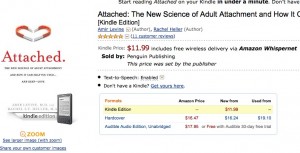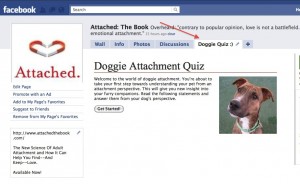We receive a great deal of emails every month. This is one of the most exciting aspects of getting published — actually hearing from flesh-and-blood people (who are not included in your immediate family) who have read your ideas and love them, or hate them, are passionate about them or just want to discuss them.
The letters we receive are mostly from readers, who write to either tell us their own personal story, to ask a lingering question about Attached, either technical or more philosophical in nature, or to dispute the ideas in the book (we’ve included one of the latter in a previous post). We also receive letters from journalists who are interested in covering Attached and from the occasional therapist or coach.
But there is also one final type of correspondence that we’ve been receiving more of lately: from people who run organizations in different locations around the globe, who are interested in including ATTACHED in their curriculum. Two such organizations are: The School of Life www.theschooloflife.com, located in London. They run programs for the purpose of thinking around everyday life issues, including two fascinating courses specifically about relationships; and Single Biz Mingle, www.singlebizmingle.com, located in Australia. They run fun, experiential workshops for over 40, professional singles. We’re very excited about these new developments and can’t wait to hear how they go. If you happen to be in England or Australia, make sure to check them out and tell us all about it.
 “Jodi”, asked us the following question:
“Jodi”, asked us the following question:
After finding and reading your book this weekend, I, too, think of myself as an Anxious-Avoidant. I write to you to suggest that maybe those of us with this rare attachment type are responding to the information provided in the book in droves because we feel that finally we fit into a category. But honestly, I was hoping to find much more information on this type because telling us that we should read both the Anxious and Avoidant Attachment information and find what fits with us feels rather general, incomplete, and frustrating.
Any specific information tailored to the small sect would be wonderfully appreciated.
Our Response:
You raise an important point and we gave the matter a lot of thought when writing the book. One of the reasons we didn’t focus on the fourth attachment style, sometimes called “fearful”/”fearful-avoidant” in our book, is that we based our work on research studies and much of the research focuses on 3 styles and not 4. When Hazan and Shaver first discovered that attachment styles could be applied to adults, they only talked about 3 styles, it was only later that a fourth style was “discovered” and much of the research continued to address the first three.
We find it most helpful in many respects to make a distinction between two broad categories, secure and insecure. People with insecure attachment styles can be either anxious or avoidant or anxious-avoidant, but in a sense people with insecure attachment styles all have the same baseline starting point—they’re all very sensitive to attachment issues in the relationship and they’re not good at expressing their feelings and communicating. So the underlying sensitivity is the same but the strategy people who are avoidant or anxious use is diametrically opposed—anxious protest, while avoidants repress. In many ways it’s easier, therefore, to shift from anxious to avoidant than to secure because you’re not changing the underlying sensitivity, you’re just changing the strategy you choose to deal with it. Research does show that under severe stress people with avoidant attachment styles react in an anxious manner.
Since you use both strategies to deal with a sensitive attachment system if you have an anxious-avoidant style, it’s best to learn all you can about both the anxious and the avoidant styles. We give this suggestion not as an afterthought, but rather very intentionally — if you tend to deal with this sensitive system sometimes by suppressing and other times by protesting, you need to get a more in-depth understanding of both mechanisms and the chapters offer a great deal of breadth on both.
Questions from both categories, like: What kind of protest behavior do I use? Which deactivating strategies do I use? When do I use these? How do I communicate my needs? etc., are the key to reaching more security for the fourth style. You need to know both strategies to use the relationship inventory appropriately.
The best solution, in the long run, is to change the underlying attachment in such a way that it will be less sensitive — which means that you will have to do less suppressing and less protesting. You do so by becoming more secure.
Ideas presented throughout the book about how secure people navigate relationships, can help you do so, regardless of your style. Specifically, priming security, or finding secure role models in your life, has been shown by research to be a very helpful and powerful tool.
“Jodi’s” response:
Thank you for the detailed reply! You are probably very right about the fact that I should now focus my energy on becoming more secure rather than obsessing over how I already am. I will definitely reread the chapters with a more open mind and heart.
Thank you again!
Thank you, “Jodi”, for the great question and for your open-mindedness!
Dodging potential heartache while keeping your eye on the ball:
One woman’s story of dating like a pro and finding great love
While writing ATTACHED, large parts of the original manuscript — many stories and even entire chapters — ended up on the cutting room floor, so to speak. One such case is the continuation of Tamara’s story from chapter 1. In the final version, we edited out part of her story and summed it up shortly on page 17. Here, we bring her full story. As with all the other cases in the book, hers is a real life story with only minor changes made to hide her identity. Here goes:
Tamara, of course, had learned everything there was to know about attachment theory and about the new discoveries we’d made – she brought the subject up in nearly every conversation we held. Some time after she and Greg had broken up, she met Rob at a cocktail party, and using her new skills, quickly determined that he was avoidant. Since he already had a girlfriend, Tamara wasn’t afraid that she might get too close to Rob and didn’t worry about spending time with him. At some point though, Rob, feeling threatened by the level of intimacy in his relationship, began to push his girlfriend, Jody, away. He started to notice minor physical imperfections and complained to Tamara that Jody talked too much.
Despite Tamara’s awareness of his attachment style and their incompatibility, she and Rob became close very quickly and before too much time had passed, she found that they were talking for hours on the phone and hugging a little too long when they parted. There was that feeling of magic between them, and yet those tell-tale warning signals were ever present: After an especially close conversation he wouldn’t call for two or three days and despite herself, Tamara would constantly think of him. She then realized that she was slowly but surely falling for him, and into a trap. Of course he wanted to be close to her, it was the perfect way to distance himself from his Jody! It helped him reassure himself that he was just fine — it was only Jody who was wrong for him.
Realizing all that, Tamara immediately took the necessary precautions. She minimized contact with him and dissipated that “special magic” between them by talking about more mundane topics, not getting physically close, and going out with him only in the company of others. She joked around with us about his avoidant behavior, “Rob had an overdose of intimacy tonight, It’ll take him a week to recover before he’ll be able to call me again.”
It became apparent to us that in dating situations, Tamara had become a changed person. Knowing about the different attachment styles gave her a new sense of power and self-acceptance. She’d grown much more confident and relaxed. Ordinarily, since she really liked Rob, she would have been tempted into believing that Jody wasn’t right for him, and that she alone had something special with him. She would have dived into this relationship headfirst only to be devastated months later when Rob replaced her with somebody else.
But none of that happened.
Tamara had a few good laughs and went on with her life. Since he didn’t get what he wanted, Rob soon lost interest in their “special friendship”. A while later she ran into him on the street. He said that things were going great; he was dating a yoga instructor and they’d been together for a few weeks. “But what will happen in a few months when it gets serious?” she asked, referring to their discussions about his aversion to too much intimacy and closeness. “Oh, I don’t worry about that. I’m just enjoying the moment,” he answered. Tamara continued to walk down the street smiling and thinking to herself: “I’m enjoying the moment too, Rob. I don’t have to worry about where you are, what you’re up to, or why you’re distancing yourself from me. And that, my friend, is a wonderful thing!”
A few months later Tamara met Tom, a clearly secure man, and their relationship developed so smoothly that we heard very little about it. It wasn’t that she didn’t want to share things with us, it was that she had found a secure base and there were just no crises or dramas to discuss. Most of our conversations now revolved around the restaurants she and Tom had been to, their plans for the future, or her career, which was in full swing again.
It’s important to remember that by going secure, if you’re anxious, you’re also saving someone avoidant from getting attached to a partner s/he isn’t going to be happy with. A true win-win situation.
Listen here to our interview with Dr. Moira Gunn on NPR. She chats with us about Attached: The New Science of Adult Attachment and How It Can Help You Find–and Keep–Love. In the book, we explore the biology behind our relationship needs, teach readers how to identify their own and loved ones attachment styles. Mariette DiChristina, editor in chief of Scientific American called the book ‘a valuable tool whether you are just entering a relationship with a new partner or-as in my case–even after you’ve been married 21 years, and had thought you knew everything about your spouse.’
 We are humbled and excited by the responses readers have been posting about ATTACHED.
We are humbled and excited by the responses readers have been posting about ATTACHED.
Thank you to our readers who have taken the time to share your feedback. Because of your support, ATTACHED has been steadily climbing the charts. We appreciate this input more than you can imagine, and we look forward to reading more of your thoughts—please don’t hesitate to share your opinion and experience!
Here are some reviews from Amazon.com, where readers are highlighting their personal experiences of the book.
“This book has really shifted the way I think about my relationships and I’m going to use a lot of the tools here to make better decisions going forward.” – T. Grand
“I felt like I was given the language via this book to pull together and understand what I have experienced my whole life and what perplexed me my whole life.” – mnsesq
“For years I had been hearing friends and others identify their behaviors with such negative labels like ‘co-dependent’ or ‘needy,’ etc. Now comes this easy-to-read, easy-to-understand book that sheds all new light on relationship patterns! I’ve learned that those former, negative labels like ‘needy’ are not really helpful – my relationship style has more to do with my attachment style.” – Donald R. Chesnut
And on GoodReads.com, user Lisa writes, “This book is incredible. I truly believe EVERYONE should read it – single, dating, married, etc. It reveals a lot about who you are and how you relate to other people, and, thankfully, there is nothing condemning in it at all.”
“Hands down the best relationship book I’ve every read, and trust me, I’ve read a bunch. Approaching relationship dynamics from the perspective of attachment theory is genius and the model fits my personal experience 100%.” – ishabazz
“I have always wondered why we were not given owners manuals or handbooks in life. I feel this book is exactly that.” – Laurie
User Karen on GoodReads.com likewise writes, “Totally changed my viewpoint of relationships. Especially since I was easily able to identify my relationship style.” – Karen
Book groups are using Attached. Therapists and coaches are giving us great feedback and people–both singles and those in a relationship–are asking us follow-up questions that we’re answering here and also on Facebook and Twitter. Follow us there! Facebook. Or Twitter.
 Studies that have looked into attachment styles and friendship have made a variety of findings, for example:
Studies that have looked into attachment styles and friendship have made a variety of findings, for example:
People with a secure attachment style are more likely to seek social support when they’re stressed; they also perceive themselves as having more available support. Avoidants, on the other hand, are more likely to distance themselves under stressful conditions. Other findings: Secures reported less conflict with friends, better conflict resolution and more satisfaction in their relationships with friends.
But more down to earth: You’ve probably noticed differences between your relationships with different friends:
With some you just know that if they’ve left you a voice message, you have to get back to them within a few hours (or days), otherwise they’ll be very hurt. If they don’t hear back from you — rather than trying you again, they’ll wait until you contact them. With others, even if it takes you a month to return their call, they’re not going to take personal offense or they’ll just keep trying until they reach you.
You’ve also probably noticed that some friendships are very intense and close while other friends,
after spending a lot of time together, will need their space and might disappear for a while.
Some friends will tell you right off the bat if something is bothering them while others will just act cold or lay low until the storm blows over.
All these aspects of friendship have to do with people’s attachment styles — and the combination of your friend’s attachment style and your own.
By understanding your friends’ attachment styles you can gain better insight into why they act as they do and you can adjust your expectations accordingly.
 We get asked a lot about the Anxious-Anxious relationship, which isn’t covered in ATTACHED:
We get asked a lot about the Anxious-Anxious relationship, which isn’t covered in ATTACHED:
What happens a lot of times is that both sides want to be very close, which is good. The only problem is that both are very sensitive, get overwhelmed easily by things that happen in the relationship and are not great communicators. Usually what this means is that when things are good they’re pretty good, but misunderstandings and fights can be terrible: Both get caught up in feeling rejected or slighted and find it hard to step out of themselves and take care of their partner’s hurt. They then often find it hard to get over it and move on. Also, both sides need to adopt the principles of secure base: Be available, encouraging (usually that’s not a problem) but also, non-interfering.
A word about the non interference part
We like to explain the non interference component by giving an example of a mother with her child in a room full of toys. If she tells him how to play each and every step of the way, “don’t do this, do that”, it shuts the child down. If she engages with him in play and/or lets him play his own way, the child flourishes. It’s very similar in adults. Either engage in “play” or let them explore on their own, but don’t “sit on top of them”.
 READER FAQ Question 1
READER FAQ Question 1
We’ve been getting a lot of questions from people who think they fall into the fourth, less common, anxious-avoidant attachment. Here’s our response:
Only a very small percentage of the population falls into the fourth, combination, category (3-5%). On the other hand, LOTS of people think they fall into this category! We call this the “medical student syndrome” – you know, when medical students are convinced they have every single symptom and disease in the textbook….
Another reason is that some of the anxious and avoidant behaviors are almost identical, so people can’t decide if they’re one or the other – and conclude that they’re both. For example, saying things you don’t mean during confilct or lashing out at your partner. So it’s important to try to figure out which attachment style is stronger in your case. Use the quiz, the “golden rules” and the “deciphering others” workshop in the book to figure it out — and focus on that one.
If after all that, you’re still absolutely convinced that you’re part anxious — part avoidant, your best bet is to familiarize yourself with both styles and work on the “relationship inventory” in chapter 9 with both styles in mind (using both the anxious and avoidant lists provided). The inventory can really help you get to the bottom of the thoughts, feelings and actions that you engage in that are getting in the way of your relationships — plus, what you can do differently to achieve better results!
Do you have a question for us? Contact us. Let us know. We’ll likely answer it here. And follow us on Twitter and Facebook.
If you have any questions for the authors, please click on “Questions and Comments” and post them in the “comment” box.

Is your dog secure, anxious, or avoidant? Take the Doggie Attachment Quiz on our Facebook page to find out.
What? Well, here’s how the Doggie Attachment Quiz came to be: After deciphering their own, or their date’s, attachment style with our quiz, our friends started commenting on their dogs’ attachment style. The first instance (on Facebook) looked like this:
R.R.: I took the quiz and found out that my dog, Rupert, and I are meant to spend the rest of our lives together! Thank you, Dr. Levine!!!!
Amir Levine: Rupert is definitely secure. With him closeness creates more closeness and that’s the secure way… When you get close to someone secure they don’t get scared and push you away. They welcome it. And pets get attached big time!
R. R.: But do you think if someone is avoidant, they can attract a secure dog?
Amir Levine: Of course an avoidant person can have a secure dog. Sometimes they may resent the dog wanting to play and be close though.

Rupert, the Secure dog
And then there was another dog, a Boston Terrier puppy named Fig. Fig is equipped with a Facebook page and a secure attachment style; she posted her results on our Facebook wall as well. So, we got to work and created the doggie attachment quiz for our Facebook page. Take it. And we hope to see you on Facebook.










